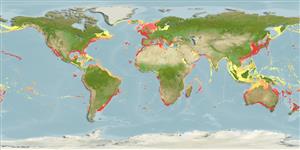Common names from other countries
>
Syngnathiformes (Pipefishes and seahorses) >
Centriscidae (Snipefishes and shrimpfishes) > Macroramphosinae
Etymology: Macroramphosus: Greek, makros = great + Greek, rhamphos = beak, bill (Ref. 45335).
More on author: Linnaeus.
Environment: milieu / climate zone / depth range / distribution range
Οικολογία
Θαλασσινό(ά) βενθικό(ς); εύρος βάθους 25 - 600 m (Ref. 9563), usually 50 - 350 m (Ref. 47377). Subtropical; 66°N - 43°S, 180°W - 180°E
Western Atlantic: Gulf of Maine to Argentina (Ref. 37039). Eastern Atlantic and Mediterranean. Indo-West Pacific. Mainly in temperate latitudes between 20° and 40°N. Presence in Somalia to be confirmed (Ref. 30573).
Μέγεθος / Βάρος / Age
Maturity: Lm ? range ? - ? cm
Max length : 20.0 cm TL αρσενικό/απροσδιόριστο; (Ref. 4508); common length : 12.0 cm TL αρσενικό/απροσδιόριστο; (Ref. 4508)
Short description
Κλείδες προσδιορισμού | Μορφολογία | Μορφομετρία
Ραχιαίες άκανθες (συνολικά) : 6 - 8; Μαλακές ραχιαίες ακτίνες (συνολικά) : 11 - 13; Εδρικές άκανθες: 0; Μαλακές εδρικές ακτίνες: 18 - 20; Σπόνδυλοι: 24. Reddish pink in color, silvery below (Ref. 5382). Body compressed, without scales. Mouth is placed at the end of the long tubular snout (Ref. 35388). Snout length (6.1cm), length of second dorsal spine (LDS 3.9 cm) (Ref. 39875).
Found between the seabed and midwater on the lower continental shelf, over sand. Juveniles found in oceanic surface waters (Ref. 2683); adults normally live close to the bottom (normally in 50-350 m depth (Ref. 47377)). Gregarious. Juveniles feed mainly on pelagic invertebrates, mainly copepods, while adults feed on bottom invertebrates (Ref. 6732). Seems to be sympatric with Macroramphosus gracilis (Lowe, 1839) all around the world (Ref. 89357).
Life cycle and mating behavior
Maturities | Αναπαραγωγή | Spawnings | Egg(s) | Fecundities | Προνύμφες
Ehrich, S., 1990. Macroramphosidae. p. 656-657. In J.C. Quero, J.C. Hureau, C. Karrer, A. Post and L. Saldanha (eds.) Check-list of the fishes of the eastern tropical Atlantic (CLOFETA). JNICT, Lisbon; SEI, Paris; and UNESCO, Paris. Vol. 2. (Ref. 4508)
IUCN Red List Status (Ref. 130435)
CITES (Ref. 128078)
Not Evaluated
Threat to humans
Harmless
Human uses
αλιεία: Εμπορικό(ά); Ενυδρείο: Δημόσια ενυδρεία
Εργαλεία
Special reports
Download XML
Διαδικτυακές πηγές
Estimates based on models
Preferred temperature (Ref.
115969): 6.5 - 22.7, mean 13.6 (based on 2092 cells).
Phylogenetic diversity index (Ref.
82804): PD
50 = 0.7502 [Uniqueness, from 0.5 = low to 2.0 = high].
Bayesian length-weight: a=0.00891 (0.00668 - 0.01189), b=2.83 (2.75 - 2.91), in cm Total Length, based on LWR estimates for this species (Ref.
93245).
Τροφικό Επίπεδο (Ref.
69278): 3.5 ±0.40 se; based on food items.
Ελαστικότητα (Ref.
120179): Μεσαίο(α), ελάχιστος χρόνος για διπλασιασμό πληθυσμού 1,4 - 4,4 έτη (K=0.36-0.46; tmax=6).
Fishing Vulnerability (Ref.
59153): Low to moderate vulnerability (27 of 100).
